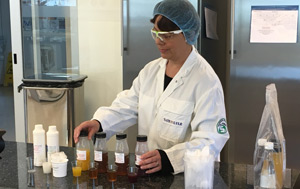Tate & Lyle’s new study shows the potential public health gains of adding more fibre to certain popular foods, including:
- More than doubling the number of young children in the UK getting the fibre they need each day 1
- Enabling 52.5% more UK adults to consume the recommended amount of fibre 2
- This increase in UK adult fibre intakes would lower their risk of developing heart disease and type 2 diabetes over the next ten years by approximately 13% and 8.6%, respectively 3
As a leading producer of soluble fibre, used to enrich a range of food and drink and support sugar reduction, Tate & Lyle has a long-standing research programme that assesses the role fibre plays in the diet to provide health benefits.
Tate & Lyle’s nutrition experts partnered with a specialist data analytics company, Crème Global, to develop new statistical modelling to explore the likely positive difference fibre reformulation could make to people’s health in the UK if it were stepped up a gear. The study assessed the potential impact of boosting fibre in the diet and resulting health benefits including the reduced risk of diabetes and cardiovascular disease.
This nutrition modelling study drew on the latest UK National Diet and Nutrition Survey data of more than 2,000 people of all ages, from which products suitable for fibre enrichment were identified. Of those products, relevant products in Tate & Lyle’s specialist categories were assessed including dairy and dairy alternatives, drinks, soups, sauces and dressings, bakery and confectionery.
Fibre is fast becoming a sought-out nutrient as consumer understanding of its health benefits grows. Doing so much more than keeping us regular, fibre can help with weight loss by making us feel fuller for longer, help to support normal blood glucose levels, increase absorption of calcium, which is important for bone health, and help maintain gut health by promoting growth of beneficial gut bacteria.
Kavita Karnik, VP Nutrition & Open Innovation
Researchers modelled the impact of enriching identified products to reach the fibre levels corresponding to the levels of ‘source of fibre' or 'high in fibre', in most cases by adding around 3g fibre per 100g.4 To model a realistic diet to deliver conservative results, researchers assumed reformulated products would be consumed 50% of the time as part of a varied diet. For instance, the diet of someone who eats a cereal every day would be modelled to see the impact of eating a fibre-enriched cereal every other day.
Susanna Palatucci, Global Head of Health & Wellness, Tate & Lyle, said: “By working with our customers to reformulate food and drink so it's healthier but still tastes great, we believe we can support public health and help improve lives. This study shows the difference recipe change can make in driving positive change in people's diets without requiring significant behaviour change. With our customers in the UK and across the world we are working hard to develop great tasting, next-generation foods and drinks that support healthier diets and lifestyles.”
Dr. Kavita Karnik, VP Global Nutrition and Open Innovation, said: “We are excited to share new insights about just what can be achieved through our collective reformulation efforts, which when added to wider efforts to boost fibre intakes through public education, will result in significant positive impact on public health. Of course, reformulation is easier in some recipes than others, and consumer buy-in for these changes is key. By building awareness of the health benefits of fibre-enriched foods, we can help increase and meet consumer demand for these products, creating a 'win win' for our industry and the consumers we serve.”
1. The number of children aged 2-5 getting recommended dietary reference values (DRV) 15g/day increased intake by 118.1% (14.9% to 32.5%) The number of children aged 5-11 getting recommend DRV 20g/day increased intake by 111.3% (10.6% to 22.4%) The number of children aged 11-16 getting recommend DRV 25g increased intake by 64.9% (5.7% to 9.4%)
2. 17+ getting 30g fibre per day increased by 52.5% (8.0% to 12.2%)
3. 13% and 8.6% relative risk reduction respectively
4. Under current labelling rules, a product with a ‘Source of fibre’ claim must contain 3g fibre per 100g or 1.5g per 100kcal. A ‘High in Fibre’ claim requires 6g fibre per 100g or 3g per 100kcal.

